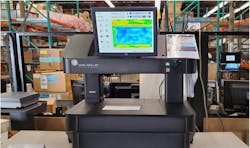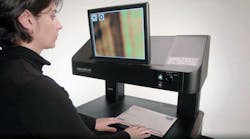RaySecur offers a new approach to mailroom screening
Ever since the Unabomber began his reign of terror in the late 1970s and shined a spotlight on the threats presented by explosives and hazardous chemicals being sent through the mail, government agencies and private sector organizations have sought out ways to better screen packages and letters for a range of dangerous substances. Try as the might; however, potentially harmful parcels can and still do make their way into corporate offices and even into the hands of executives and other prominent figures.
Last August, Dr. Anthony Fauci, Director of the National Institute of Allergy and Infectious Diseases who has been at the forefront of the nation’s response to the Covid-19 pandemic, opened an envelope filled with an unknown powder that was later determined to be a non-threatening substance. In January, pharmaceutical giant AstraZeneca was forced to briefly evacuate one its manufacturing plants in the UK responsible for producing the company’s Covid-19 vaccine following a suspicious package scare.
Even though many of these threats turn out to be hoaxes, the loss of productivity and fear inflicted upon an organization’s workers due to these events is significant. And while some large organizations deploy X-ray screening solutions to try and mitigate as many of these incidents as they can, only a limited number of packages can be sent through meaning that just a small portion of their mail ultimately gets scanned.
However, RaySecur has developed a new desktop-sized 3D scanner dubbed “MailSecur” that leverages millimeter wave technology to scan packages for a wide variety of threats. MailSecur, which is the first mail scanner to receive DHS designation as a Qualified Anti-Terrorism Technology (QATT) under the DHS Safety Act, is being demonstrated inside the RaySecur booth (#608) at this week’s GSX conference in Orlando.
According to Alex Sappok, Ph.D., CEO of RaySecur, which was founded in 2015 after being spun out of National Optics Institute in Quebec City, Canada, and is now based in Boston, the lack of adequate mailroom screening technologies is one of the biggest unaddressed security vulnerabilities in organizations both large and small.
“You can’t walk in any office building today without multiple layers of security screening – whether that’s badge access, controlled checkpoints, video cameras, security guards and check-in desks, etc. And you can’t send emails to a company without those being scanned for cyberthreats,” Sappok explains. “The gap we see is that physical goods show up on a daily basis – letters, packages, Amazon boxes, Uber deliveries and bike couriers dropping stuff off – and nine times out of ten, all of those items get delivered to the intended recipient, whether it is the CEO’s office, into the heart of a datacenter or R&D facility.”
MailSecur vs. X-ray
In contrast to X-ray machines, which use ionizing radiation and thus poses health and safety concerns, Sappok says MailSecur leverages millimeter waves as the foundation for its imaging technology making it safe to use everywhere.
“You need a radiation permit for any location you drop an X-ray machine into and then you also need a TSA-level trained operator to run it,” Sappok adds. “That makes it very difficult for large companies that might have a couple hundred locations to deploy an X-ray in each of those locations. A large corporation might have one, two or three X-ray machines at a headquarters, but they’ve got a hundred other sites that are receiving mail deliveries, and nothing is being done.”
Additionally, while X-rays are good tools for finding large threats – guns, knives, explosives, etc. – Sappok says most mail threats today are small, letter-sized parcels that would not be easily recognizable with these machines.
“Most threats are coming in in small packages and the vast majority are liquids, powders – oftentimes hoaxes where someone is dropping in a couple of teaspoons of sugar and it lands on a CEO’s desk and the next day their headquarters is shut down until they determine that it is not a viable threat,” he says. “An X-ray doesn’t do a very good job of imaging powders and liquids. It is very energetic, which is why it does a great job of blasting through things like metal and seeing through very dense items, but it is also the reason why you have to take out your liquids or cosmetics at the airport. X-ray is not going to be able to see if the bottle is full or empty if it is a liquid. That’s the reason why the powder threats, the liquid threats, the potential chemical and bio threats always end up in the news, because even if people are using X-ray screening it is not seeing those kinds of threats and they are going through undetected.”
How It Works
MailSecur provides images of package contents in real time and because it uses a safe imaging technology, users can interact with it more freely, thereby enabling them to move a parcel around at different angles to confirm whether or not it contains a threat.
“Think of it like looking through your digital video camera – you’re seeing items around you and we’re looking through a digital camera in the same way but we’re seeing inside of those items,” he explains. “If there is a powder inside or liquid, you’ll actually see the grains of power or liquid moving around inside the item. It is very intuitive, and it makes it easy for people to use and interpret what they are seeing. They don’t need a ton of training.”
On top of the scanner itself, RaySecur also provides a service to its customers that enables them to transmit images via the cloud to a network of former EOD (explosive ordinance disposal) experts for further analysis should they want or need a second opinion. MailSecur can also integrate with building security and controls systems from Johnson Controls, which recently invested in the company in its latest $13 million funding round, enabling facilities to immediately take action to mitigate a threat. For example, if a suspicious powder is identified in a package, all the doors in the immediate vicinity could be locked to contain the threat or it could automatically shut down the building’s HVAC system to prevent it from spreading.
Being an early-stage technology company, Sappok says they have focused much of their attention thus far on the corporate security market and count a number of Fortune 500 companies among their customers; however, they also have deployments with government agencies and are screening mail for various heads of state around the world. During the 2020 U.S. presidential campaign, the company was also tapped to help the Pete Buttigieg campaign screen mail for threats.
To learn more about RaySecur, the MailSecur 500 or MailSecur 300 scanner, drop by booth #608 during GSX this week. You can also see their full C•CURE integration in the Johnson Controls meeting room #W209C.
Joel Griffin is the Editor of SecurityInfoWatch.com and a veteran security journalist. You can reach him at [email protected].




